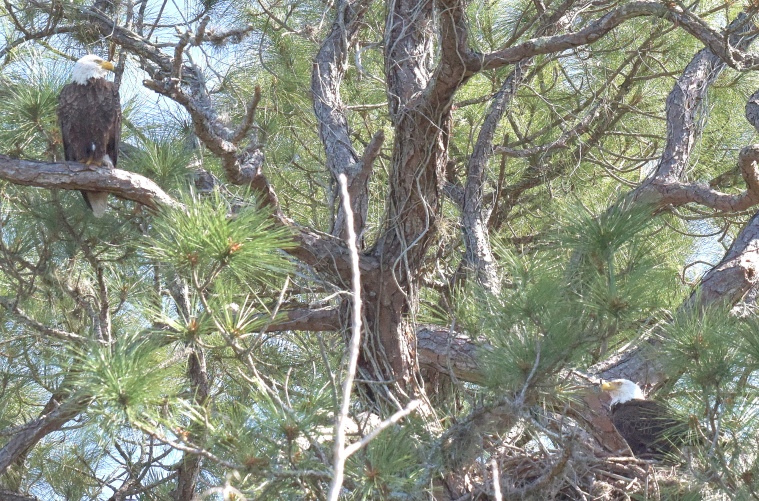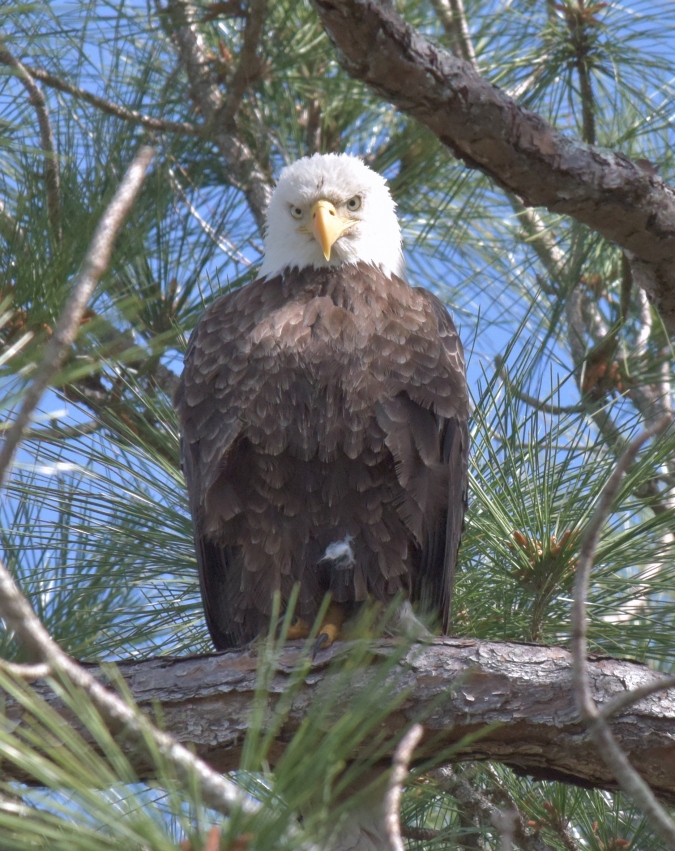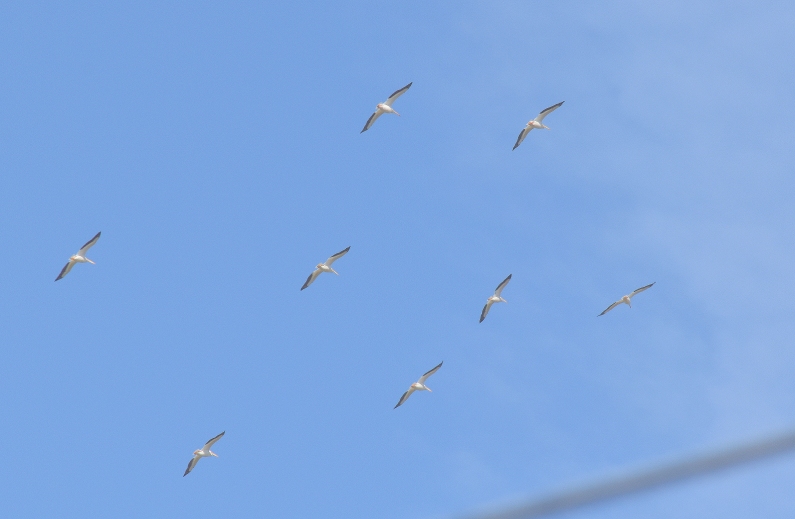Introduction
There are numerous bald eagle nests in Sarasota County, but you have to know where to look. It may surprise you to know that the contiguous state with the most eagle nests is Florida, although it is sometimes cited as being neck-and-neck with Minnesota. Currently, nationwide statistics are relatively sparse; many bald eagle studies were discontinued in 2007, when this raptor was removed from the Endangered Species List. Suffice it to say, however, the national bird of the United States is doing very well, thank you.
I have occasionally spotted bald eagles on my home turf of Siesta Key, despite the fact that there are no nests on the island. There are a number of active nests across Little Sarasota Bay on the mainland, and I have to assume that Siesta Key falls within the hunting grounds for these eagles.
The Sarasota Audubon Society sponsors bus tours of local nests this time of year, as this is breeding season and there are many eaglets to observe. I jumped at the chance to climb on board today. There are usually a couple of experienced naturalists running the tour, as well as a host of grizzled veterans who know way more than I do.
Today, we made a total of seven stops on the Eagle Trolley. They weren’t all eventful ones, but some were quite good. The distances and lighting conditions were not ideal for photography, so the photos below are a “best effort”.
In the interests of space, I will focus on two of the seven stops: (1.) a nest just outside the entrance to the new Cassia Skye Ranch development, and (2.) a nest near the Loreto Court Bay Access in Nokomis.
Outside the Cassia Skye Ranch Development
This is where we saw the most action today. Unfortunately, the Google map below only shows the approximate location of this nest…but it is pretty close.1 You can zoom in or out, as needed, to orient yourself.
At this stop, we visited a nest with two eaglets. One of the naturalists on the tour stated that these birds were only 8 – 12 weeks old, and didn’t yet know how to fly. Before presenting the photos, I should point out that young eaglets have primarily brown feathers. The adults that you’ve seen in books and magazines with their stunning white head and tail feathers are at least five years old.
The pictures below were difficult shots (for me, at least!) This was due to a combination of a dynamic scene, visual clutter from nearby leaves and branches, and poor lighting conditions. (The sun was almost behind the eaglets, so they were partially silhouetted.) That said, I’m surprised I got what I did.
During our visit, one of the adults (presumably the male) arrived with a half-eaten fish for the eaglets to finish. It’s fairly common among raptors for the male to catch the food, and then get the first crack at the catch. Once sated, he then brings the rest of the meal to the female adult and chicks. In the photo below, the male is flying in from the left, dangling the partially eaten fish in his talons. The two eaglets (with their brown feathers) are in the nest to the right:

Here is a better view of the adult eagle carrying the fish:

Satisfied with a job well done, he basks in glory near the top of the tree. If you look closely, you can see the white head feathers of a second adult just behind him and to your left:

Fortunately for us birders, the drama wasn’t over. While we were there, a juvenile eagle flew in from parts unknown and tried to crash the party:
 An interloper eagle unexpectedly flew in and created some excitement. (Note that, in flight, eagles tuck their landing gear under their tail feathers.)
An interloper eagle unexpectedly flew in and created some excitement. (Note that, in flight, eagles tuck their landing gear under their tail feathers.)
This chap is probably two or three years old, since he’s sporting a fair amount of white feathers (but doesn’t yet possess the white head). He made a number of passes around the area of the nest, before being ushered away by one of the adult eagles.
Loreto Court Bay Access
The last stop on the tour was a nest just off Loreto Court in nearby Nokomis, FL. Fortunately, we could get reasonably close to the nest itself, and the lighting was fairly good. The approximate location of the nest is shown in the Google map below. Once again, feel free to zoom in or out, as necessary, to get a feel for where you are.
As you can see from the map, Lareto Court dead-ends just before the water (Dona Bay). If you stand at the end of the road, look eastward and a little to the left of the road. The nest is hard to miss. I’ve included the best shots below.
This pic shows the mated pair in the same photo. One of the eagles is in the upper left (on a branch), and the other is in the lower right (on the nest itself):

It is difficult to distinguish the male from the female from a distance. The female is generally a bit larger than the male, but this is hard to discern when they are well-separated, as in the above shot. Females being larger than males is called Reverse Size Dimorphism (RSD), and is in fact common among raptors. The reason for this has not been conclusively established, but there are several favored theories:
- Incubation duties are shared, but not equally. The female spends much more time on the eggs than the male. Furthermore, in the early stages of development, eaglets cannot regulate their own body temperatures,2 and require supplemental heat from the parent. Both observations favor a larger female
- A bigger, more powerful bird would be beneficial in keeping the nest safe from the inevitable predators
- A smaller, leaner male is more advantageous in hunting elusive or agile prey
Below is a close-up of the eagle perched in the branch away from the nest. He does not look particularly happy at the attention he is getting.3 Note that the eyes are recessed in their sockets…a protective measure to avoid injury. Eagles, like many other raptors, cannot, in fact, move their eyes very much within their sockets. To monitor prey or threats in their periphery, they actually have to move their entire heads. This gives rise to the “odd” head movements often observed in raptors.4

And here is the other adult eagle, sitting at the edge of the nest. She is showing off her best eagle profile.

You may wonder where the young eaglets are. At this early stage, they don’t know how to fly, and so are confined to the nest. We only saw evidence of one eaglet today, and he was very difficult to spot. Every once in a while, he would flash his dark brown wing for the camera. Here it is, to the left of the adult:

Fortunately, the adult eagle knew enough to turn his head away whenever this happened, although I did see him get whacked in the head a couple of times.
Addenda
One of the bonuses of outings like this is the unexpected sighting. Before we even got started, I caught this painted bunting foraging among the ground cover near the Nature Center:
 A painted bunting among the ground cover. This was my first-ever sighting of this bird.
A painted bunting among the ground cover. This was my first-ever sighting of this bird.
While walking back to the bus after one of the stops, I spotted several small flocks of wood storks projected against a nearly-cloudless blue sky. Each flock of 5 – 10 birds glided in unison, tracing lazy circles in the sky. It was mesmerizing to watch:

Thanks for following my blog, and happy birding! ♦♦♦
1 After this photoshoot, I discovered to my shock and dismay that Nikon had removed the built-in GPS for D5000-series cameras, like my D5600. This decision was apparently made to quote a longer battery life in the specs. GPS information is available to the camera via the SnapBridge bluetooth connection to my IPhone, but I was unaware at the time that this was needed. (I guess it’s OK to run the IPhone’s battery down. Grrr!)
2 Most birds, like mammals, are warm-blooded.
3 When I don’t know the sex of a bird (which is 99+% of the time), I default to the masculine pronouns.
4 I have a blog post in preparation on this subject, and will provide a link here when it is published.

Thanks for the information
Very interesting
LikeLike